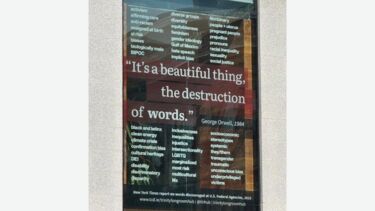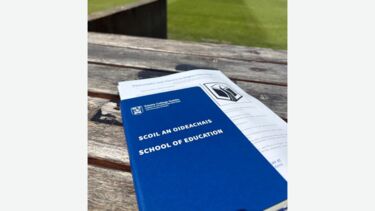On Tuesday 10th - Thursday 12th June 2025, members of the critical disability studies community and Wellcome Trust Anti-Ableist Research Cultures (WAARC) project team attended the Philosophy and Theory of Higher Education Society (PaTHES) Conference entitled, ‚ÄòThe Creative University‚Äô.&≤‘≤˙≤ı±Ë; The conference was jointly hosted by Trinity College Dublin and University College Dublin. The setting (Trinity College Dublin) was beautiful and conference organisers provided a warm Irish welcome - poetry, dancing and music. We did however note barriers to access in both the venues or the delivery of presentations themselves. This reminds us of the continual work of , an inclusion of papers on disability and intersectionality as well as a broader representation of Disabled people with different access needs to enable felt inclusion of those within the room.
This year, the PaTHES conference asked us to critically engage with notions of ‘creativity’ within higher education agendas and discourse and to reclaim its conceptual richness as an affirmative life-force, resisting against pressures of innovation and problem solving but instead centring interdependencies, meaning and connection. This has taken inspiration from idea of ‘a thousand tiny universities’: universities that must facilitate incremental but meaningful, purposeful and creative spaces to push for change and disruptive potential. In this blog post, each of our members will detail the papers presented and seek to align their work with a creative and anti-ableist higher education. Together, we will assemble our thoughts to consider how we move forward with those mundane, micro but purposeful points to create a better and more inclusive higher education and university.
Our first talk was Dr Armineh Soorenian who presented her work entitled, ‚ÄòReclaiming Disability as a Tool for Creativity in University‚Äô.&≤‘≤˙≤ı±Ë;Armineh began her work by acknowledging how disability is often situated with a deficit model. In a traditional neoliberal higher education context, with ever decreasing funds, it is assumed that having impairment/disability, one would need expensive aids and adaptations to be able to work and study, rendering Disabled staff and students financially undesirable. In thinking about creating an inclusive university, Armineh suggested a different higher education: one which welcomes and desires Disabled people, while redefining disability as a tool for creativity, liberation, adaptation, and thinking outside the box to change the status quo. Reframing disability as an affirmative and life-giving force centres our hope, joy, resilience and resistance. Re-conceptualising disability as creativity allows us to rewrite the narrative about disability, narratives that are not centred around our bodily dysfunctions, but about our contributions to the university community. Disability requires us to be flexible and adaptable, to come up with often inexpensive inclusive practices and adjustments, and new forms of participation. With shifts in our energy levels, moods, concentration, focus and interest, ability to read and write, ability to sit and move, we embrace our differences, access needs, resisting ableism, ableist norms and bureaucratic challenges in academia that try to suppress our creativity. By doing so, we open possibilities for teaching and learning and embed an inclusive culture that benefits everyone. Armineh then shared her own lived experiences of working in a university on the WAARC project as a disabled researcher, voicing her embodied experience of facing multiple barriers at various stages of the research process. She then went on to detail how as a team of Disabled and non-disabled researchers, we resist normative structures and through our daily processes and actions, we find creative ways to support each other, while learning together, enriching and nourishing each other‚Äôs experiences. As a diverse team, we use disability as an opportunity for creativity, fostering a generative movement to think, discuss how as a team of how we can be interdependent, meet each other‚Äôs access needs, to find new ways of being in university community and hope for an accessible and creative future to practice liberation together.
Next up, Dr Cassie Kill presented work entitled, ‘Mobilising Creative Methods to Reimagine the Anti-Ableist University Otherwise’ developed in collaboration with Dr Daniel P. Jones. The paper considered the challenges to imagining the university otherwise, drawing on the WAARC anti-ableist university zine sessions in late 2024 to illustrate the value of artistic research practices in overcoming such imaginative deficits. The presentation began with a critical engagement with EDI work, drawing upon contention that:
‚ÄòEDI risks becoming a policy distraction if we fail to challenge the ableist and colonial architectures of the university‚Äô.&≤‘≤˙≤ı±Ë;
Cassie further discussed comments on the ethical limits of EDI work and work on the complexity of attempting to make utopian spaces within the academy. Considering the as an example of imagining the university otherwise, Cassie discussed how Daniel’s process-led and emergent approach to zineing was central. She focussed on a piece she had created for the zine which constructed a piece of poetry from the collective conversations, as an example of poetic inquiry. As a whole, the paper advocated for the affordances of artistic approaches in spawning and nurturing new ways of thinking, feeling and practicing the university, contending that they therefore have a powerful potential as anti-ableist practices.
We then had a team effort where Liz Dew, Dr Cassie Kill and Professor Rebecca Lawthom collaboratively held the session, ‚ÄòParasitic Leadership and Professional Services Work as Everyday Creative Activism in the Neoliberalist Ableist Academy‚Äô.&≤‘≤˙≤ı±Ë;Cassie began their symposium by contextualising and theorising the tensions, challenges and opportunities involved in working in the neoliberal-ableist university with an ethical commitment to anti-ableism. Drawing on notions of institutional hospitality and the work of Michel Serres, Cassie theorised the complexities and contradictions of working within, against and possibly beyond the currently existing academic institution. Cassie explored the affordances of the figure of the parasite - a somewhat heroic figure, which occupies and feeds from a powerful host whilst nurturing other goals, at odds with current arrangements - suggesting that this offers a generative model for understanding creative acts of resistance involved in working across professional services and academic leadership. Following this, Liz reflected upon experiences of looking to crip professional services as a disabled worker. This included offering critical reflections on how one can involve subversive attempts to queer, crip or otherwise bend the very bureaucratic processes professional services colleagues are responsible for upholding as a creative process with varying levels of ‚Äòsuccess‚Äô. Significantly, there is an acknowledgement of the work required to do this, with the inevitable facing of structural forces at play and the encounters of ableism and disablism that force such conversations in the first place. To compliment the work of Cassie and Liz, Rebecca offered her thoughts by centering ‚ÄòCare, Culture and Interconnectedness‚Äô in her reflections as a leader in the School of Education and its opportunity to practice community. Rebecca detailed the backdrop of the antiquated idea of the lone scholar amidst the structural pressures of juggling academics balancing research, teaching, impact and community engagement. And yet, there is a necessary reminder that the making and re(making) of culture belongs to everyone. But to do this requires time, supporting wellbeing and collaborative creativity. Themes that also align with pedagogies of joy described shortly by Lauren. As Rebecca notes, whilst people inside the system might talk about ‚Äúthe university‚Äù as if it were a singular and stable entity, it is necessarily made up of us all: multiple interconnected entities, in relation with one another. Centring this interconnectedness is at odds with ableist notions of the autonomous individual worker ), and instead makes space for community and care. We become able to dwell in ‚Äòa thousand tiny universities‚Äô : possible through cherishing a different way of being in the institution.
Finally, Dr Lauren White, gave a presentation entitled, ‘’ on behalf of the broader collaborative team. This presentation sought to make two central arguments. The first argument is stressing how we must advocate for joy and enjoyment in higher education: namely in this context, within learning and teaching. The second argument is about bringing together philosophies of joy, inspired by Spinoza who saw joy as an affect characterised by 'opening up' and 'interconnection' with the world, and for who articulates joy as an 'affinity with life' that activates our potential. For us, we align these affirmative philosophies with critical pedagogies (; ; ) to make for better learning and teaching encounters. To tell this story, Lauren detailed working in close collaboration with students to explore joy and enjoyment in higher education with creative and participatory research methods. Students co-constructed meanings of joy and its relationship to higher education and university life, as well as creatively engaging with accounts that detailed what conditions might be necessary for a joyful pedagogy to exist in current and future higher education. Much of this is anti-ableist - challenging norms of metrics, productivity, ways of working, thinking, being and timeframes that do not suit diverse bodies and minds. A creative, collaborative and inclusive approach is needed if we are to make higher education better and significantly more enjoyable to be in. What made this presentation most joyful is the fact that Lauren and co-presenters took their theory into practice and presented it on the grass, in the sunshine and beyond the walls and constraints of the academy.
So what brings us together as a community? Our work illustrated a diverse patchwork of ideas and approaches - all deployed towards making the University a more creative, inclusive and less ableist setting. We note the necessity of collaboration and interdependence - this happens in a multitude of ways. First, in working together to conduct research with methods of co-production in the case of Lauren’s work with students as co-researchers and co-creators of knowledge and creative methodologies. Second, in evidencing the ways in which researchers, leads and professional services can come together to create shared understandings and common threads in the case of Cassie, Rebecca and Liz. And third, in the collaborative and careful work Armineh achieves in working alongside Liz and others to promote and work towards an anti-ableist university.
Much like critical disability studies, the necessity of collaboration and interdependence evokes a creative and disruptive notion that we must locate and indeed centre with pockets of refusal and resistance. This is whilst also remaining committed to disability, access and inclusion as the welcoming and celebrated driving force of academic life. The PaTHeS conference acted as a microcosm for the ways in which we all engage within the university, albeit shared commitments which manifest in a diversity of ways. But in the spirit of a thousand tiny universities , this is a diverse and creative community to cherish and to celebrate.



